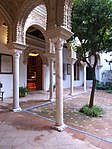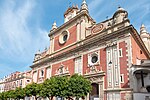Casa de Pilatos
Azulejos in buildings in AndalusiaBuildings and structures completed in the 15th centuryBuildings and structures completed in the 16th centuryHouse of MedinaceliMudéjar architecture in Andalusia ... and 2 more
Palaces in SevilleRenaissance architecture in Seville

La Casa de Pilatos (Pilate's House) is an Andalusian palace in Seville, Spain, which serves as the permanent residence of the Dukes of Medinaceli. It is an example of an Italian Renaissance building with Mudéjar elements and decorations. It is considered the prototype of the Andalusian palace. The Casa de Pilatos has around 150 different 1530s azulejo (Spanish glazed tile) designs made by the brothers Diego and Juan Pulido, one of the largest azulejo collections in the world.
Excerpt from the Wikipedia article Casa de Pilatos (License: CC BY-SA 3.0, Authors, Images).Casa de Pilatos
Plaza de Pilatos, Seville Casco Antiguo
Geographical coordinates (GPS) Address Phone number Website External links Nearby Places Show on map
Geographical coordinates (GPS)
| Latitude | Longitude |
|---|---|
| N 37.3899 ° | E -5.98711 ° |
Address
Casa de Pilatos
Plaza de Pilatos 1
41003 Seville, Casco Antiguo
Andalusia, Spain
Open on Google Maps











